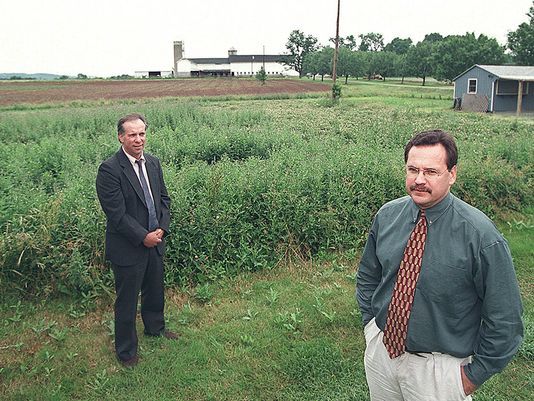To Our Friends in the Keep It Green Coalition & The Farm Bureau

Bill Wolfe (left), then-policy director of the Sierra Club’s New Jersey chapter, and Jeff Tittel, the director of the environmental advocacy group, discuss farmland in Hopewell, Mercer County, that they hoped to preserve in 2000.
(text to the caption and Photo: Courier-News file)
The Courier News dredged up this oldie but goodie to accompany a smear by a nuclear industry shill, a hit piece with this incredibly Orwellian title:
I wouldn’t waste my time reading the smear, but I couldn’t resist sharing the photo.
I’ll let Tittel respond to the Sierra smear, but I must expose the huge lie at the core of Mr Gutherman, the “rabble rouser’s” arguments, i.e. the cost issue. Gutherman claims
[Sierra Club] wholeheartedly supports the Environmental Protection Agency’s economy-killing, unscientific reductions in fossil power plant emissions that have repeatedly failed any realistic cost-benefit analysis.
That is a flat out lie – the cost benefit analysis on EPA’s proposed existing power plant rule demonstrated huge net economic benefits, at least $50 billion per year.
That economic analysis shows that it is fossil fuels that are killing the planet and costing the economy trillions of dollars (and how do you even quantify the risk of loss of ecological function of the ocean? or of inability to conduct agriculture? or inundation of coastal cities? or deadly heat waves? Economists are just beginning to get a handle on estimating the costs of extreme weather, droughts, and floods, which are the most obvious current climate impacts. Sandy, one climate related storm, cost over $60 billion.)
So, getting back to the topic of this post, for all our friends over at the Keep It Green Coalition and the Farm Bureau, don’t say I don’t support preserving farmland.
Every picture tells a story, so for some of our readers who may not be familiar with the context for that 14+ year old photo, note that it was taken in Hopewell in 2000. So, that gives me a chance to repost the story I shared recently in a post on Ballot Question #2.
It talks about the relative roles of voluntary willing seller based open space preservation versus what is smeared as “socialistic planning” and “command and control regulation”.
It is an argument I stand by that that remains important given the debate on restoring Ballot Question #2 diversions and open space implementation legislation – and it too responds to lies:
Hopewell Is A Poster Child for Why Open Space Diversion is Fatally Flawed
… Hopewell lands were protected from sprawl development by the very watershed planning and water quality management programs that the open space ballot initiative would severely cut.
Hopewell, in the mid 1990′s, became the battleground and statewide focal point for what was then called the war on “suburban sprawl”. I was a resident of Hopewell at the time and was proud to be engaged in this fight.
These battles publicly revolved around massive development plans that involved extensions of sewer lines into Hopewell to support intensive development.
Millions of square feet of new commercial development and thousands of new residential units would have been served by the proposed massive increase in sewer infrastructure and capacity, including along Scotch Road/Merrill Lynch, the BMS campus in Pennington, and north along Rt. 31. These debates included expansion and upgrade of the Pennington treatment plant.
[and if those sewer lines were built, land values would have increase 10 times or more, making an acquisition strategy cost prohibitive.]
A few years later, there was another major development battle at the Berwind site – this one involved expanding an old package wastewater treatment plant and various regulatory restrictions imposed by a DEP Category 1 stream designation.
The common denominator and decisive factor in all these debates was the science and regulatory requirements of DEP’s watershed planning and the water quality management programs.
Those are exactly the same DEP programs that would be slashed by the Open Space ballot diversion.
It is incredibly disingenuous – and just flat out wrong – for Waltman to ignore this history and regulatory reality in his arguments in favor of Question #2.
On top of all that, following these major battles that local environmentalists won, Hopewell built on that success by adopting perhaps NJ’s most innovative and science based Master Plan and zoning scheme, which is based on water resource capacity – both water quality and water quantity.
Again, it is exactly that science, watershed and water resource capacity based planning, and regulatory programs that preserved so much land in Hopewell that would be slashed under the Open Space diversion.
No town in NJ provides a more compelling example than Hopewell of the value of watershed planning, water quality management, and DEP science and technical support programs.
It is extremely shortsighted and totally counterproductive to sacrifice those very effective programs on the mantle of a half baked, rob Peter to pay Paul, open space funding scheme.

Pingback: Quantum Vision System